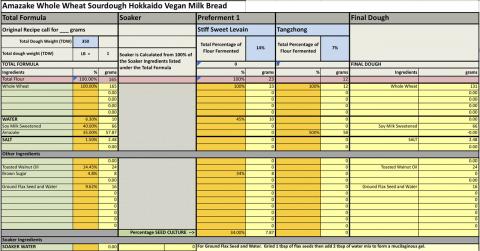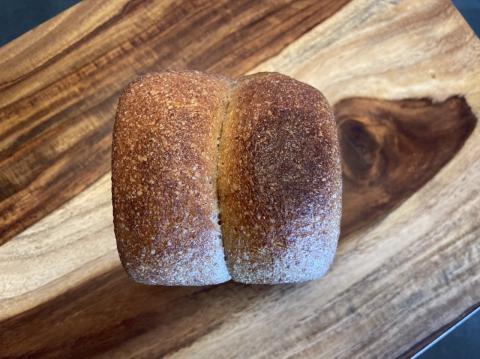
Amazake Whole Wheat Sourdough Vegan Hokkaido Milk Bread
In my earlier blog post I described how I made my first ever amazake from scratch. It is delicious, rich and sweet despite there being no added sugar. Today I am doing a test bake of an Amazake Sourdough Vegan Hokkaido Milk Bread. The amazake was used to make the tangzhong. Because it is so sweet I didn’t add any sugar to the dough as I usually would. I’m hoping that I have enough dough to fill the 10x10x10cm pullman pan I have and that it’ll bake up into a nice cube.
Instructions
Levain
Mix the levain ingredients in a jar or pyrex container with space for at least 300% growth.
Press down with your knuckles or silicone spatula to create a uniform surface and to push out air.
At a temperature of 78ºF, it typically takes up to 10-12 hours for this sweet stiff levain to be at peak. For my starter I typically see 3-3.5 times increase in size at peak. The levain will smell sweet with only a mild tang.
Tangzhong
Put about 1” of water in a sauce pan set on medium high heat. In the bowl of the stand mixer stir the amazake and flour until blended. Then place the bowl on the sauce pan to cook the tangzhong (Bain Marie) for several minutes until well thickened, stirring regularly with a spoon or heat-resistant spatula. Theoretically it should reach 65ºC (149ºF) but I don’t find I need to measure the temperature as the tangzhong gelatinizes at this temperature. Let cool in the bowl and then refrigerate until the next morning.
Flax seed gel
Grind 1 tbsp of flax seeds and combine with 2-3 tbsp of water and stir to form a thick gel.
Dough
Into the bowl of a stand mixer with the tangzhong, add the soy milk (consider holding back 10 g of soy milk and adding later if this is the first time you’re making this), ground flax seed gel, salt, and levain. Mix and then break up the levain into many smaller pieces. Next add the flour. I like to use my spatula to mix until there aren’t many dry areas. Allow the flour to hydrate (fermentolyse) for 20-30 minutes. Mix on low speed and then medium speed until moderate gluten development this may take 5-10 mins. You may want to scrape the sides of the bowl during the first 5 minutes of mixing. Next drizzle in the toasted walnut oil a little at a time. Slow the mixer down to avoid splashing the oil at you. The dough may come apart, be patient, continue to mix until it comes together before drizzling in more oil. Once all the oil has been added and incorporated increase the speed gradually to medium. Mix at medium speed until the gluten is well developed, approximately 10 mins. You will want to check gluten development by windowpane during this time and stop mixing when you get a good windowpane. You should be able to pull a good windowpane, not quite as good as a white flour because the bran will interrupt the windowpane somewhat.
On the counter, shape the dough into a tight ball, cover in the bowl and ferment for 4-4.5 hours at 82ºF. There should be some rise visible at this stage.
You can next place the dough into the fridge to chill the dough for about 1.5 hours, this makes rolling the dough easier to shape. Remember, if you do so the final proof will take longer. Alternatively, you can do a cold retard in the fridge overnight, however, you may find that this increases the tang in your bread.
Prepare your pans by greasing them or line with parchment paper. I used a muffin pan oiled with walnut oil.
Lightly flour the top of the dough. Scrape the dough out onto a clean counter top and divide it into six. I like to weigh them to have equal sized bun. Shape each tightly into a boule, allow to rest 5 mins. Flatten each boule, divide it into three pieces shaping each into a small boule. Place each set of three small boules into the muffin tin to bake into a three lobed bun.
Cover and let proof for 3-5 hours at a warm temperature. I proof at 82°F. You will need longer than 3-5 hours if you chilled your dough for shaping. I proof until the top of the dough comes to within 1 cm of the top edge of the pan.
Preheat the oven to 350°F.
Bake 20 mins lid on then remove lid and bake further 10-15 mins.
pH of the dough after mixing completed was 5.52.
pH of the dough at the time of baking was 5.02 with a 100% rise.
I’m guessing that I’ll need to make an additional 50-75 g of dough to properly fill this pullman cube pan when baked with the lid on. Not bad for a first time baking with the new cube pan though. I’ll post the crumb and flavour later when the bread cools.








Comments
This bread is delicious, the flavour is a bit more complex than the vegan buns I made recently with a similar recipe without the amazake. I wasn’t sure that the sweetness would be enough or in fact that it might be too much because the amazake does taste quite sweet. However, it turned out with just a hint of sweetness just as I like it. I’m quite happy with this bake other than the fact that I didn’t get the cube loaf I wanted! I’ll be baking this again.
8208EF2C-2034-4472-8706-B52911825B11.jpeg
EFDD21DB-818D-443C-AC9A-34405F15725E.jpeg
Bennie - another excellent bake.
It's nice to see a plant-based (vegan) versions of bread recipes. I'll have to give this one a try at some point.
Tony
Thank you kindly Tony, I appreciate it. You should give this a try. It is impossible to replace the flavour of dairy with non dairy products. However, there is a whole different deliciousness that you can get with plant based products for these soft sandwich style breads. I also baked this as buns using soy milk instead of the amazake of this recipe and it was also really delicious. The amazake brings a subtle sweetness and the crumb seems more fluffy and soft. I wondered if that was from the proteases that the amazake has.
Benny
It looks delightful!
Thank you Marta, it is quite delicious and I’m really glad to have made this new bread.
I repeated this bake because it was soooo delicious eventhough I didn’t actually need more bread. I increased the dough weight to 425 g to see if I could get it full cube shape. It was soooo close just the top corners aren’t sharp. I’ll have to increase the dough weight just a bit more or allow it to proof a bit more, but I would like the sharp corners.
E84DA19B-3BA9-4C6A-827A-E708A660C157.jpeg
F44A5F57-1E88-49CE-B7BC-C2B9DB325619.jpeg
1A3BBADA-20EC-4E98-BE64-962F8258BBBC.jpeg
3AF4A2F2-B13A-4AA2-A8D3-D77CCB5B8620.jpeg
11A0A1C7-C1A0-42C3-BA4F-B7124DB1B0F9.jpeg
I actually think the round corners are so cute!
And soy milk bread sounds like a dream!
Thank you very much, glad you like it. You should give the soy milk a try, it works really well as a dairy substitute.
Benny
What exciting bakes! And the fact that you repeated it means it was as good or nearly as good as the dairy version?
Nice to see the flax seeds getting used there as well. How did you work out how much of that to use?
-Jon
Thank you you Jon, as I said you cannot fully replace the flavor of dairy, so if you’re making something vegan you want to choose things that you’ll enjoy the flavour of themselves. The toasted walnut oil is excellent for flavour along with the soy milk so those were easy substitutions. Then I suddenly have gotten into playing with koji and discovered how awesome amazake is and thought that the sweetness and umami would be great to use in the tangzhong and was totally right about that.
The research I did for this vegan bread was that to replace the whites of one egg were that 1 tbsp of ground flax seeds hydrated with 2-3 tbsp of water work well. What I actually wanted to use was aquafaba but then I ran into an issue of forgetting that many canned chickpeas are salted so the aquafaba ended up too salted and my first test dough wouldn’t rise. I’ll try again in the future with no salt chickpea aquafaba.
I then went to replace the fat in the yolk which is 30% fat and the fat in the butter which is 80% fat with the equivalent approximate amount of toasted walnut oil.
For the milk, which I always used skim milk I just replaced it 1:1 with soy milk which I used sweetened because I like to drink the sweetened stuff. So I eliminated the sugar from the dough since the soy milk was lightly sweetened and the sweetness of the amazake I felt would sweeten the bread enough and I am so happy with the final bread.
Have you ever tried amazake Jon? I hadn’t until just this past week, so delicious I’ve already gone through my first batch and made a second one.
Benny
I haven't tried it, but you've certainly got me curious.
Did some digging and there is a place locally I found selling bottles of amazake drink, but think they've been sterilized (so not for making bread). They also had Koji starter, but seem to be out of stock at the moment. I need to look some more for other places.
I’m converting a portion of my sweet amazake to sour, you do this by just letting it sit in a warm environment for 7 days or so. I don’t think that the amazake cultured butter was quite right. I’m hoping that by using sour amazake it might do a better job of acidifying the cream and getting the cultured cream going properly.
Amazake is really quite a tasty drink, it is surprisingly sweet and to think that all of that sweetness is unlocked by the power of the amylase from the aspergillus is quite remarkable.
The store bought amazake should be fine at least to try drinking it. You could certainly use it as I have as a tangzhong liquid where you aren’t depending on the microbes to do anything but where you want the flavour of the amazake. It would be cool if you can find some koji rice to play with. I’ve been having fun reading about koji and happy to share whatever I’ve learned so far with you.
I made a short video.